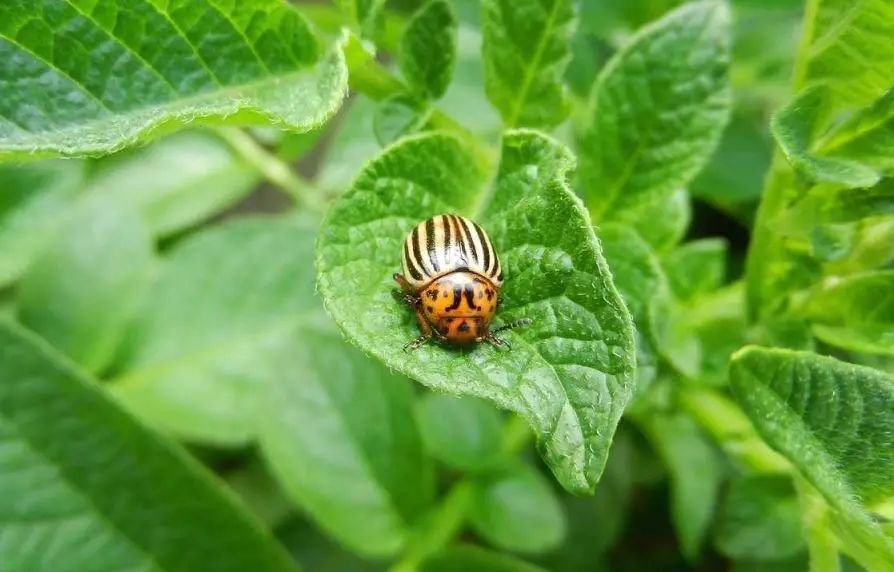Destructive garden pests may destroy garden produce and test your gardening abilities in Montana, Nebraska, Wyoming, and the Dakotas, just as they can in other regions. Here are the 10 most harmful insects for residents of these states and a list of other pests that may be hiding among your garden plants.

Destruction-Producing Insects in South Dakota and Beyond
Aphids – The most prevalent garden pest, aphids, harms plants by sucking off the sap and spreading illnesses to other plants. Aphids gather on the underside of the leaf, making chemical management of them useless. Instead, use forceful water blasts from the hose to chase away these pests and then release predatory insects to control population growth.
Blister Beetles – These corrosive insects are especially harmful in alfalfa fields, but they also cause the defoliation of garden plants, including peas, beans, tomatoes, and potatoes. These insects release a poisonous body fluid that may blister skin. Hence it is not advised to hand-pick them. Shake diseased plants over a pail of hot, soapy water to eliminate and capture these pests. Carefully dispose of the water and dead insects since they carry the bacteria that causes blisters.
Cabbage Looper – A significant pest of cruciferous crops, cabbage looper larvae consume leaves and tunnel into cabbage heads. In contrast to applications of Bt (Bacillus thuringiensis) made as soon as the eggs hatch, pheromone, and light traps may diminish the number of adult moths.
Colorado Potato Beetle – Unlike their name, Colorado potato bugs are among the most destructive garden pests in the Pacific Northwest, South Dakota, and Nebraska. Additionally, they terrorize other nightshade family members in addition to potato plants. You may control population growth by manually collecting or vacuuming adult beetles, larvae, and eggs from plants and soil.
Cutworms – A cutworm is probably to blame if you see young plants with their roots severed close to the soil surface. During the day, you may find these nocturnal feeders in the soil around the bases of plants. Put a 4-inch (10 cm) tall cardboard ring around the plant stems to protect transplants and seedlings.
Flea Beetles – Adult flea beetles cause damage to foliage by repeatedly chewing small holes in it, as opposed to the larvae, which dwell underground and may harm the roots of vegetable plants. This insect may be prevented from harming garden crops by tilling the soil in the autumn and using row coverings.
Grasshoppers – These ravenous bugs consume twice as much food as they weigh each day and favor some of the most delectable garden produce, such as beans, carrots, lettuce, onions, and sweet corn. These insects can be controlled with a flock of hens or ducks in the backyard, but a garlic spray may also work.
Mexican Bean Beetle – These insects from Dakota, Nebraska, Wyoming, and Montana cause problems in gardens east of the Rocky Mountains by skeletonizing the leaves of beans, okra, and eggplant. Tilling beneath plant residue in the autumn will help keep populations from overwintering in the garden.
Thrips – These little insects feed on plant juices by piercing the leaf. Silver speckling and white spots on leaves are signs of their deterioration. Although employing adhesive strips, neem oil, or insecticidal soaps might assist, controlling thrips can be challenging. To avoid overwintering, remove garden detritus, particularly onions.
Tomato hornworms – These intimidatingly huge caterpillars may also be rather destructive. Tomato plants may rapidly lose their leaves when hummingbird moth larvae are present. The best methods of management are removing caterpillars from plants and spring-tilling the soil.
Additional bugs in North Dakota, South Dakota, Wyoming, Montana, and Wyoming
- Aspargus Beetles
- Black Grass Bug
- Bumble Flower Beetles
- Cottony Maple Scale
- Cucumber Beetle
- Diamondback Moth
- European Earwip
- Frit Flies
- Green June Bug
- Harlequin bugs
- Hollyhock Weevils
- Japanese Beetle
- Leafhoppers
- Potato Psyllid
- Purple Carrot Seed Moth
- Rose Curculio
- Sap Beetles
- Slugs
- Spider Mites
- Squash Bug
- Squash Vine Borer
- Tomato Fruitworm

